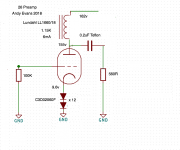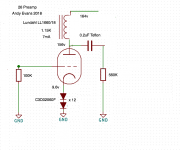Practically do the diodes warm up at all with such tiny loads? More importantly with the SICs on both the 01A and 2P29L, which valve do you like more? Does the venerable thoriated 01A still have the magic. Thanks again.
I haven't looked into heatsinking yet. I don't heatsink when I use these devices in a hybrid Graetz bridge for the negative side, which would be about 140mA current for the whole amp circuit.
My initial listening on the 2P29L is that you get a real boost in clarity. I can hear lyrics to vocals at low volumes which I couldn't before. I need more time to assess overall listener satisfaction. As for the 01A, it's been said many times that these thoriated tubes give you extra treble sparkle, and that remains true. So go for that if 4mA is enough for you, or if you use Ale's source follower. Apart from that added sparkle the 2P19L does just about everything well. I like it and use it every day because at 12-16mA it drives my PSE 4P1L output stage. I could use the 10Y which also has the added sparkle but I leave my system on 24/7 and I don't want to wear out these valuable tubes. I have a box full of 2P29L.
As for the 26, Ale and I have stopped using it because for low currents (max. 7mA for a 26) the 01A is simply better. But I'm curious to hear what the 26 sounds like with these SIC diodes. Since I have a string of 12 giving 10v I can try this out and report back. I use a modular construction for all my projects with various top plates I can put together, so I can play around without much rebuilding.
Well..... the 26 in SIC bias. This is really very nice. The diode bias is on the bright side, and the 26 gives it some nice richness and warmth while retaining all the clarity. This is a very nice surprise. I was despairing of what to do with all my 26s and this is the solution. I like the sound of this and I'm going to leave it in my system for a while. It's a total lash-up with dropper resistors everywhere so needs to be rebuilt, but this looks like it's going to be worth it. Good day's work!
Attachments
Well..... the 26 in SIC bias. This is really very nice. The diode bias is on the bright side, and the 26 gives it some nice richness and warmth while retaining all the clarity. This is a very nice surprise. I was despairing of what to do with all my 26s and this is the solution. I like the sound of this and I'm going to leave it in my system for a while. It's a total lash-up with dropper resistors everywhere so needs to be rebuilt, but this looks like it's going to be worth it. Good day's work!
Hey Andy, I guess that 560R load reads 560K?
I would have been surprised if the 01A worked well and the 26 didn't.
Why not just use fixed bias and remove everything from the cathode circuit?
Diode bias IS fixed bias....
Yes a curve that gives 0.5-0.6% regulation for 15-20% change in anode current! In fact anode voltage regulation is recommended......
Hey Andy, I guess that 560R load reads 560K? I would have been surprised if the 01A worked well and the 26 didn't.
Yes, of course - 560K. thanks for pointing that out.
Well, I've been neglecting the 26 for a while because I couldn't get it to sound as good as the other DHTs I was using, but this incarnation is impressive. I'd be interested in some feedback from anyone else that can build it.
Attachments
Andy wich pins do you use in the LL1660 for 18mA 1K15?
Why don't use the LL1660 Alt S 4:4.5 10mA 130H to avoid the output capacitor as I do?
Why don't use the LL1660 Alt S 4:4.5 10mA 130H to avoid the output capacitor as I do?
Last edited:
It's all in the Lundahl data. You just use the primaries. I prefer the sound of plate chokes with a teflon output cap, FT-2 x 2 here. The Lundahl was just the first thing I had to hand. For my daily listen preamp I'll use the NP Acoustics amorphous plate choke, 136H, 15mA. That's my favourite. Just experimenting right now - this SIC diode bias is completely new to me. It's a little bright sounding but very detailed, so I'll have to see how it lasts over prolonged listening.
I'd be interested in some long-term listening tests on this SIC diode bias. They are on the bright side, and I'm starting to wonder if they are a little too bright and slightly edgy. First impressions are positive because of all the added clarity and detail, but I'm wondering if I can get the smoothness I want for long-term listening. I currently have the 26 in SIC bias in my system, and I'll leave it for a while so I can see if I can live with it. My fall-back option is 2P29L in filament bias which is smooth enough for me with the smaller NP amorphous plate choke. I'll have to move that plate choke into the 26 to see if that makes a difference. So not 100% convinced yet. As above, all feedback welcome.
.....My initial listening on the 2P29L is that you get a real boost in clarity...... I leave my system on 24/7.....
Thanks Andy. Now I'm curious why you don't turn your valves off, even in a heat wave?
Last edited:
Thank Andy. Im curious why you dont turn your valves off?
My Mac is the source of all my listening activity - all my music is on an external hard disc and my playlists are in iTunes. Then there's all the online stuff - TV (freeview on my Mac), YouTube etc. Everything goes through my amps. So I have the amps on during the day. At night I usually listen to some music to send me to sleep, so in the end there's not much point in turning the system off.
It could be a case of too many series connected sic diodes imparting too much square law effect. If a bit more brightness compared to resistor bias is desired, there is an option of combination resistor and sic bias. Just replace some of the diodes with a resistor of appropriate value to maintain bias. 🙂I'd be interested in some long-term listening tests on this SIC diode bias. They are on the bright side, and I'm starting to wonder if they are a little too bright and slightly edgy. ...
It could be a case of too many series connected sic diodes imparting too much square law effect. If a bit more brightness compared to resistor bias is desired, there is an option of combination resistor and sic bias. Just replace some of the diodes with a resistor of appropriate value to maintain bias. 🙂
I was wondering about that myself....must try it. Though you couldn't use too large a resistor. e.g. 3 volts at 7mA gives you 428 ohms. I don't want to use cathode bypass caps. This would work better with a 2P29L at 14mA. 5 volts would give you 357 ohms. That would be half of the bias.
Last edited:
Quite possible. I haven't looked up all the data on heatsinking, if there is any. Can anyone give me ballpark figures for these SIC devices?
- Home
- Amplifiers
- Tubes / Valves
- 01A question

